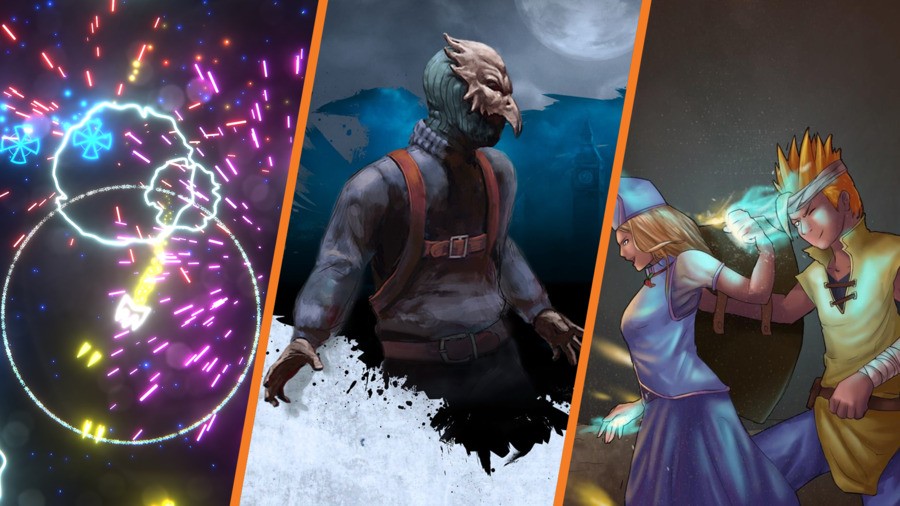
This week, we have some solid entries from the Indie scene, bringing you five more lovely titles to potentially add to your library. Atmospheric puzzler Inops delivers some quirky brain teasers via platforming, The Raven Remastered offers a Switch port of a mystery solving classic, Utopia 9 – a Volatile Vacation gives us decent twin stick rogue like action, Heroes Trials is a hidden gem RPG, and Debris Infinity delivers more frantic and satisfying twin stick action with a retro space shooter skin. Let’s take a look, shall we?
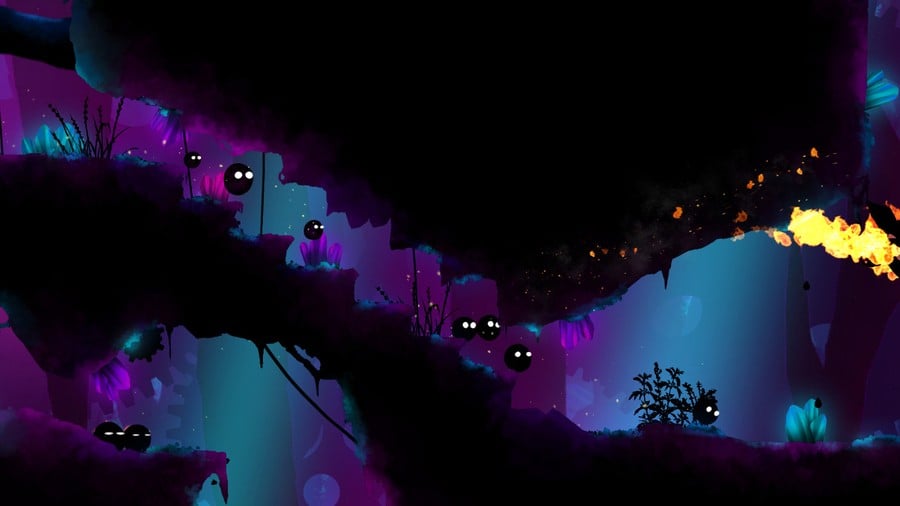
Inops
Combining a visual aesthetic akin to Limbo with some solid platforming puzzling, Inops is a charming experience that speed runners will love to blaze through as quickly as possible. Your goal is to collect small black blobs called ‘Inops’ scattered, asleep, throughout the level and use them to solve puzzles and reach the level's end. The twist comes from the ability to combine the creatures with the Y button, to form one mega Inop, which can do things that the herd cannot, such as make higher jumps. It’s stylish and intuitive, though some of the puzzles can occasionally be a tad sloppy.
While the gameplay is incredibly fluid and usually spot on responsive, the environmental puzzles can be a bit fiddly. Rather than controlling a puzzle immediately upon touching it, you have to use L and R to highlight it, which, while not a huge issue, can be frustrating on some of the later, more intense levels. However, with that as its main criticism, there isn’t a whole lot not to like about Inops. You’re scored on how many of the creatures you’re able to collect, as well as three stars dotted in each level. However, these stars require clever puzzle solving and quick reflexes to solve, so they’re far more akin to New Super Mario Bros. than dreadful mobile games. The game also offers a speed run mode, allowing you to time yourself and storm through each level for a personal best, which can be compared to players around the world via a ranking board.
We loved Inops’ visual style. The gloomy look of the creatures, silhouetted in black against colourful backgrounds, is really quite appealing. The Inops themselves are also delightfully endearing, with their cute monster noises and big white eyes. The enemies are also varied and adopt a delightfully adorable version of hell-spawn demons. Musically, the soundtrack is decent, and fits with the mysterious theme of the art style, though it doesn’t leave a huge impact. Overall, Inops offers great platforming-puzzler action. Its creative style, mixed in with some decent platforming and an intuitive way to solve environmental puzzles make it a gem to discover.
Thumbs Up
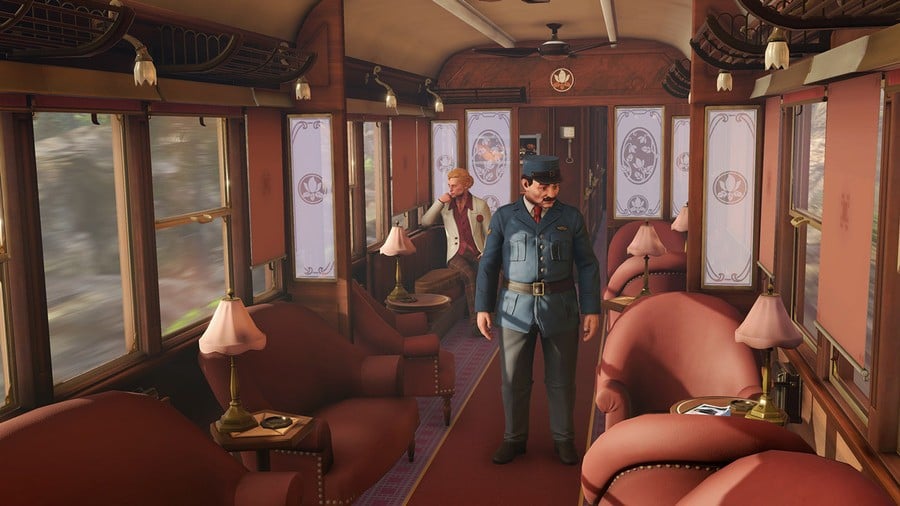
The Raven Remastered
A bizarre choice for a remaster, The Raven Remastered doesn’t add a whole lot more to the original mystery adventure: The Raven: Legacy of a Master Thief. However, this is the first time we’re able to play the game on Switch, so it’s a welcome addition. The Raven takes inspiration from classic murder mystery novels – such as the work of Agatha Christie – putting a firm focus on story, in addition to a number of murder mystery homages and easter eggs, which certainly isn’t a bad thing for this kind of game. The narrative is spread across the viewpoints of a handful of different and well-developed characters across three key chapters. The writing is strong, with a wit that adds to the charm and allows some levity during its darker moments.
As expected, gameplay revolves around using your wits and applying what you’ve learned by talking to characters to overcome obstacles in varyingly creative scenarios. This is mainly split between exploring different dialogue options to further the story and environmental puzzle solving, mixed in with some classic point and click influences; picking up key items, combining them to solve puzzles, and the like. The 1960s setting is a really nice choice, and takes the player to a variety of different locations, crucially offering much-needed variety to the puzzles. The game also revels in its status as a ‘whodunnit’ mystery and uses its compelling narrative cleverly by weaving it into the gameplay, making progression addictive, as you always need answers. Unfortunately, it’s let down by occasional graphical performance issues, which can be a bit of a nuisance or can offer some accidental hilarity. While we encountered nothing game-breaking, this is far from ideal for a remaster.
The setting and art style of The Raven Remastered are both top notch. The '60s costumes, set design, and environment really work to develop its own style, and the cartoonish approach is a great concept, in theory. Unfortunately, this element is let down by the character models, whose facial expressions make them look as if they’ve been put through a blender. It’s a shame, because the world is well crafted, and a less ambitious design approach to the human models might’ve avoided this major drawback to the game's look. Where it does succeed, however, is in its sound design, which boasts both a compellingly beautiful orchestrated score and excellent voice acting. Overall, as a port to the Switch, the Raven Remastered is a great introduction to the mystery adventure genre. Minor graphical quirks and nasty-looking faces aside, this is a well-developed story with well-integrated gameplay.
Thumbs Up
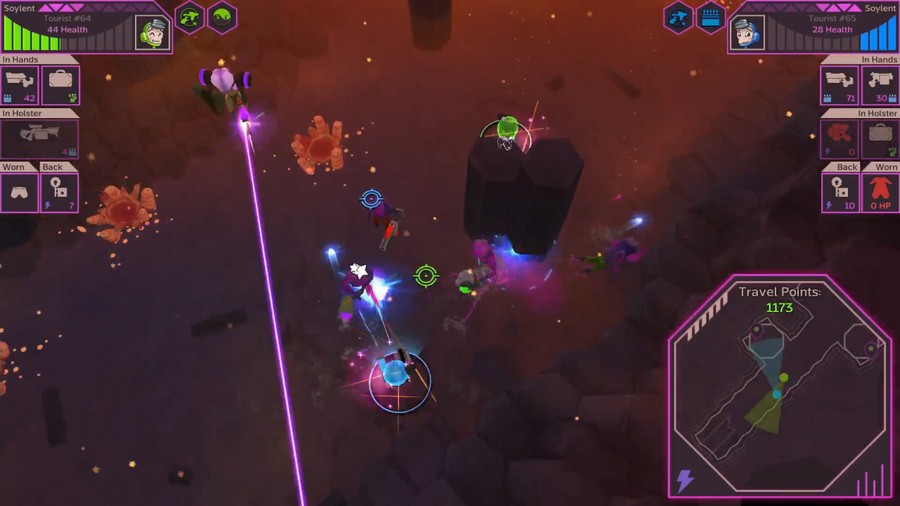
Utopia 9 - A Volatile Vacation
Utopia 9 is a roguelike twin-stick shooter; not the most refined, but not the worst either. Though it boasts a quirky premise and has a so-so visual style, the roguelike gameplay is well done and it implements some interesting choices that let it stand out from the pack: it’s just unfortunate that not every element hits the nail on the head. The premise, admittedly, is cute. You’re on a ‘vacation planet’ that in actuality has scammed its residents into fighting off hordes of mutants. You even use your suitcase as your primary melee weapon, which is a nice touch.
The expected roguelike elements are all present here: upgrades, weapons to find, and of course, permadeath. The upgrade system comes in the form of mutations. As you progress, you’ll have the opportunity to warp your own DNA for additional perks, such as bouncing bullets, faster rates of fire, and many, many others. Experimenting and upgrading your arsenal with these through different playthroughs offers the most enjoyable element that the game has to offer. The unique addition of an enemy nemesis system, where they evolve upon defeating you is also a really cool concept that is executed well, but can lead to some cheap deaths if you respawn nearby them. The combat is OK, but a bit on the sluggish side, as well as being unforgivingly hard in some places. For single player, the reward of progression and trying out new perks and weapons is fun for sure, but may not hold players over for hours and hours of playthroughs. However, throwing a friend into the mix for co-op can actually lead to some really great teamwork-based action, as the second player tips the scales a little more and makes the fighting more manageable.
Visually, Utopia 9 isn’t all that great. Taking a top-down perspective, it can be difficult to decipher exactly what anything is, at times. The monster designs are a bit generic, and the world doesn’t stand out as anything special. The sound design is also poor, with a distinct lack of music in the stages, and generic sound effects for both guns and enemy hits that both lack impact. In review, Utopia 9 offers a volatile experience, indeed. The roguelike elements are fun, and on a good run can lead to some decent action, but with a weak aesthetic and somewhat slow combat, this won’t be for everyone. Good for multiplayer co-op, though.
Maybe
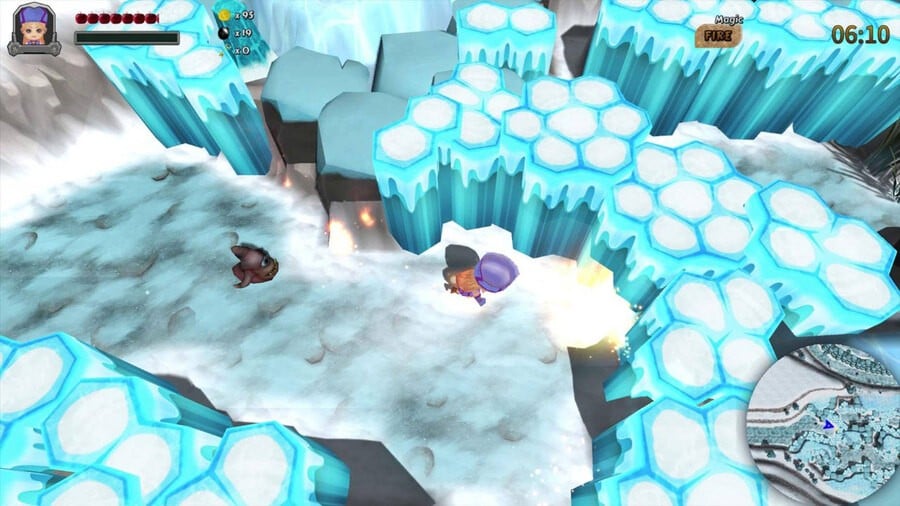
Heroes Trials
Sometimes, simplicity and a healthy dose of charm can be all you need for a short and sweet game. Heroes Trials is certainly short, simple, and charming. An RPG that bases itself around different levels – or ‘trials’ – it boasts solid (if basic) combat and a pleasing buddy system that has you swapping between two main characters. The plot is pretty bare-bones but is serviceable. You play as siblings Elia and Zoel, who must prove their worth as the new guardians of the land by completing the titular trials to qualify for the positions. As you might tell, it isn’t exactly Citizen Kane, but the dialogue is well written and has the odd amusing line.
Gameplay-wise, the swapping mechanic between mage Elia and warrior Zoel makes for a more varied experience that is surprisingly engaging. We found Elia’s long-range magic to be the preferable choice, but you’ll have to use both of them to solve certain puzzles throughout the adventure. With the hearts in the UI, semi top-down perspective, and character designs bearing more than a passing resemblance to the original Legend of Zelda, it’s almost like you’re swapping between Link and Zelda, which is pretty ace. Trials are time-based, which can lead to some frustrating and tense near misses. Between the puzzle solving, frantic exploration, and sharp combat, you’ll have to think fast to navigate each dungeon or area to complete your objective. The main issue with the game is how short it is, as it can be beaten in just a few hours (though there are secrets to explore during free roaming sections).
Visually, Heroes Trials opts for ‘chibi’ versions of its main characters, which actually adds a lot to its charm factor. The characters look cute and endearing, while weapon animations look fiercer, though the ‘poof’ effect made when enemies die might just be a little too silly. The soundtrack is also well done, with suitably light and fluffy motifs, followed by more epic iterations later on. In review, Heroes Trials is a bit of an RPG hidden gem. It’s criminally short, but cuts the fat of many RPGs and gets straight down to the action. If you’re looking for a game to storm through that has solid combat, puzzles, and exploration, you might just find it here.
Thumbs Up
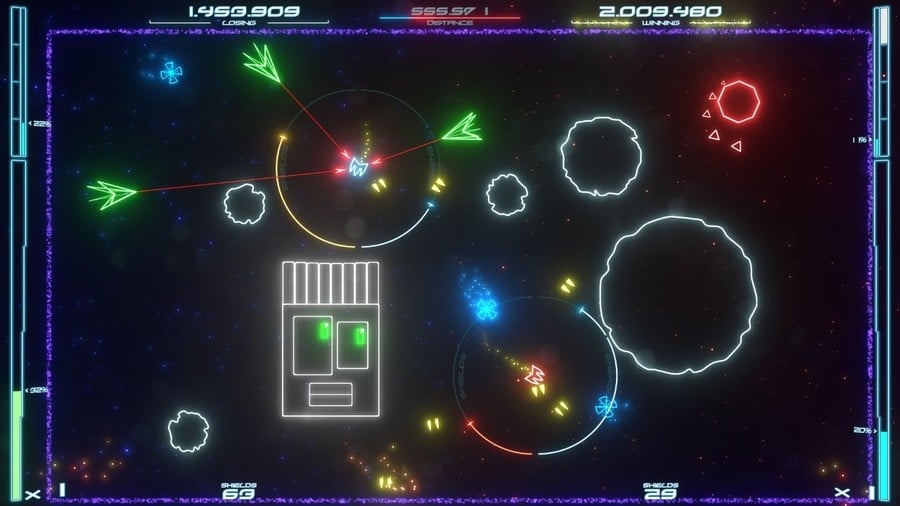
Debris Infinity
A twin-stick shooter with oodles of depth, Debris Infinity is one addictive beast. Taking the visual style of arcade classics like Asteroids and infusing it with a neon coat of paint, the aesthetic is as impressive as the gameplay. The frantic and often challenging arcade-style battles really make this a game that tests your reflexes as well as your strategic thinking. Debris Infinity basks in the glory of its arcade influences and revels in its own nostalgia with a pumped-up tech soundtrack, '80s style robotic voiceover, and a focus on high scores. Its main appeal, though, is its fast-paced and frantic gameplay, which really gets the heart pumping.
Gameplay is divided arcade style into three main modes: Time Attack, Normal, and Power Wave. Though all are fairly similar, they provide slight gameplay variations that allow you to practice your shooting for the best score in slightly different scenarios. For example, Normal mode has you surviving for as long as possible, whereas Power Wave gives you additional time for every wave of enemies that you successfully destroy. Though its style is intentionally rudimentary, its action has surprising depth, with a variety of factors leading to power-ups, or additional score bonuses. For example, you receive a ‘reflex bonus’ for destroying an enemy as soon as they appear on screen, and as your streak of kills increases without you taking damage yourself, you’ll gain additional streak bonus. The coolest addition by far, however, is the ability to slow down time for a limited period during each match. While it doesn’t totally freeze the screen, this great feature allows you to catch your breath during particularly insane moments, but must be used wisely. The multiplayer element also features a versus mode, which works well, and a co-op mode that is a little trickier, as players control the movement vs shooting respectively. This actually makes for some tense local fun, and certainly requires a strong degree of teamwork for success. The control is slick though, and there is little to complain about in this department.
Visually, as stated previously, the game adopts a classical style reminiscent of the early Atari era, albeit with sharp textures and some impressive bright neon effects. The enemies also become more detailed and varied the further you progress, so you won’t just be battling asteroids and random shapes forever. There isn’t a huge amount to dislike about Debris Infinity. Being limited to three similar modes may mean that it has the potential to become stale, but we found the variety in gameplay elements pushed us to beat our own scores and strive to progress further, with repeat playthroughs.
Thumbs Up
Will you be checking out the frantic gameplay of Debris Infinity, or purchasing any of the other games from this week’s Nindie Round Up? Let us know below.



Comments 18
I have Debris Infinity, and uninstalled it after a few days of play. Maybe I'll give it another try. I think I was expecting to to be far more like Geometry Wars, and the addition of asteroids in every level really threw me off... I don't like fighting rocks for the entire damn time.
Im glad these all seem to be good games in their specific genres but none of them really speak to me as games I would enjoy... Back to my backlog while I wait for the slew of upcoming gems in the coming months.
I’d love if these round ups had different scoring systems. I know it’s not fair to give them a full review score when these are only meant as small handy round-ups, but I still feel like after reading the synopsis I can’t tell how much the game was enjoyed. Even if there was a difference between a thumbs-up and a highly recommended.
I would have given The Raven a "Maybe", myself. Unless they did some work to optimize it for Switch, it ran horribly on PS4 despite being an upscaled Xbox 360 game, and some of the puzzle solutions were utter nonsense. Not quite "Gabriel Knight 3 cat/mustache" levels of bad, but the kind where they make you run around clicking on everything when you've otherwise solved it but the game won't progress until IT says so.
@aznable Debris Infinity being similar but different to Geometry Wars is something I appreciate. It's a different flavor of twin-stick shooter and for the price I find it really polished. For score chasing is great and it certainly is a looker on handheld when lots of effects are all over the screen maintaining 60fps
I was hoping for some info on reverie but oh well
I'll vouch for Debris Infinity. It's a great game I've had a lot of fun playing. I also really like the time slow down power. I love the 60 fps visuals and there's one track that I always find compelling when I hear it. The curious thing about this game for me is that the title screen looks surreal when it swoops in with perfect letters moving at 60 fps. Somehow it looks fake, or pre-rendered, or something. I like it though!
Also, thanks for piquing my interest in the other games. Switch has such a ridiculous number and variety of games it's impossible to keep up with!
I love that we seem to be getting past the flood of wannabe 8-bit games! I was getting real burned out on every other indie title trying to make a game that looked worse than something running on an NES.
Nothing for me there, but thanks for the round up anyway
"Unfortunately, it’s let down by occasional graphical performance issues"
That's standard for THQ Nordic. They just pump games out with little care for quality. You would be hard pushed to name any game from them that doesn't have bad framerate, screen tearing and clipping. They said recently they have over 70 games in development so it's no surprise their games have these issues.
@60frames-please Does Debris Infinity have online leaderboards?
@OorWullie Yes it does.
@60frames-please Cheers.
@60frames-please @OorWullie
Is Debris Infinity compelling enough to combat my Tetris 99 addiction though?!
Debris Infinity is a masterpiece. I often come back to it.
I just picked up Toridama Brave Challenge, and it's a blast! Great stand in for anyone wishing for Warioware on Switch.
I got Untopia 9 and was immediately disappointed that it runs at 30 fps. There are many great top down twin stick shooters on Switch, Tesla vs Lovecraft comes to mind (and it runs at 60 fps), so unless frame rate doesn't matter to you I'd advise staying away from Utopia 9.
Tap here to load 18 comments
Leave A Comment
Hold on there, you need to login to post a comment...